Blue spiders are some of the most beautiful and fascinating creatures in the world! and although there are many different species of blue spiders, each one has its own unique patterns and characteristics.
Seeing a blue spider is relatively rare, so there’s nothing quite like the thrill of spotting one in the wild for the first time. However, the problem most people have is how to identify the species of spider.
So, in this blog post, we will discuss 16 different species of blue spiders and how to identify them. Let’s get started…
16 Blue Spiders And How To Identify Them
1. Brazilian Blue Spiders
The Brazilian blue tarantula spider “Pterinopelma Sazima” is a species of tarantula from the family “Theraphosidae” and is native to an ecological island within the Chapada Diamantina National Park in Bahia, Brazil.
This type of spider grows up to 15cm and prefers warm climates with temperatures of around 20 °C. They also spend most of the day hiding in burrows or under rocks.
At night, they will venture out in search of food. When looking at one of these spiders straight away your notice their legs and body are blue!
However, what separates them from other blue spiders are the red hairs located on their abdomen. Seen in the photo!
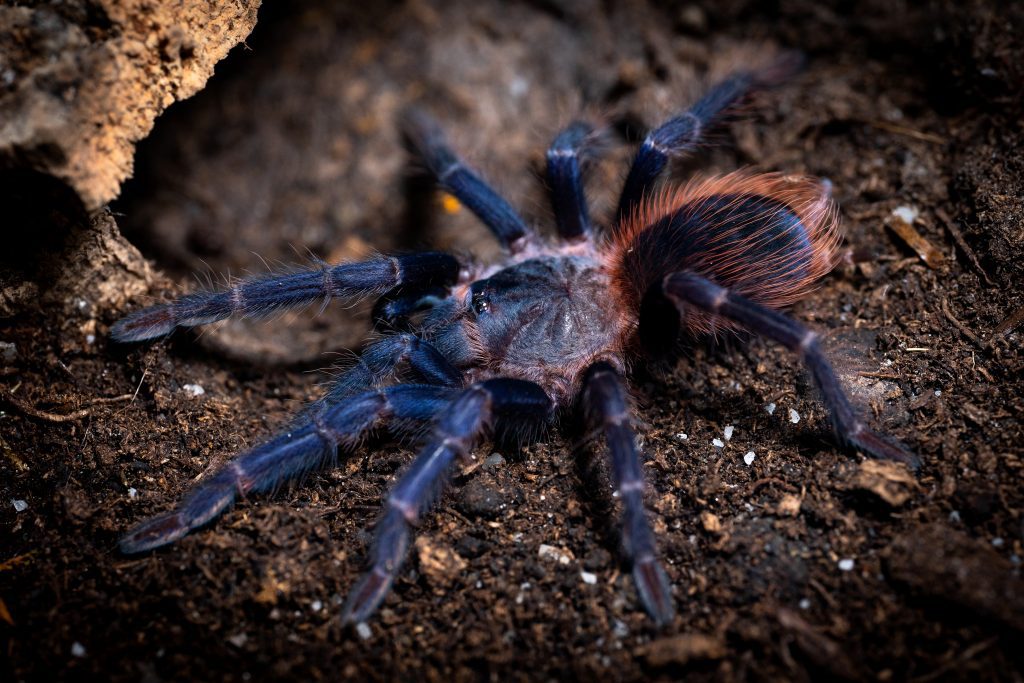
You should also notice that they have a light gray prosoma, and opisthosoma, with darker gray chevrons. If the spider you’re looking at has these colors it’s likely you have found a Brazilian blue tarantula.
Characteristics
- Red hairs located on their abdomen
- Light gray prosoma, and opisthosoma
- Dark gray chevrons
Habitat
- Native to tropical forests
- Hiding in burrows or under rocks
Related Articles:
2. Peacock Blue Tarantula
The peacock tarantula spider is the only blue spider of the Poecilotheria genus and is native to southern India around the forest of Andhra, Pradesh. However, because of deforestation, these spiders are considered an endangered species on the IUCN Red List.
The peacock tarantula gets its name from its stunning colorful patterns on its legs and abdomen, which resemble the tail feathers of a peacock.
They also have a noticeable blue prosoma and opisthosoma with white patches running down the center.
The females are covered in blue hair whereas the mature males have a more brown prosoma and are more slender than females with longer legs up to 20cm.
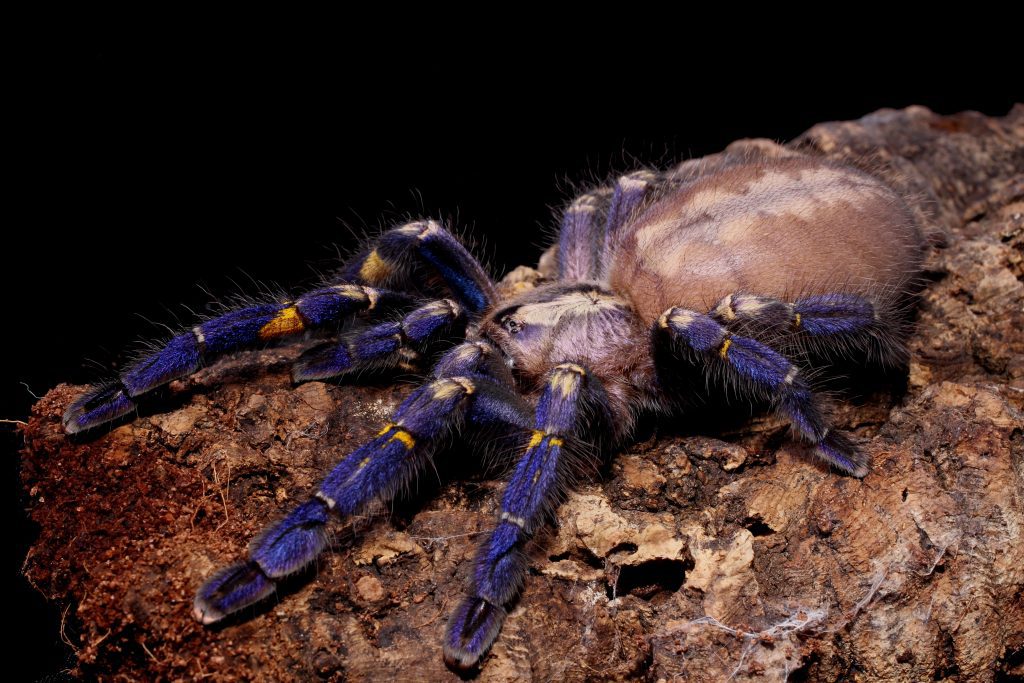
Another key feature is both the males and females have blue legs with tiny yellow rings at the top of each knuckle and their abdomen will be light gray with dark spots.
Characteristics
- Resembles the tail feathers of a peacock
- Blue prosoma and opisthosoma
- Yellow rings at the top of each leg knuckle
Habitat
- Native to the forest of Andhra southern India
- Hiding in burrows or under rocks
3. Cobalt Blue Tarantula
The Cobalt blue tarantula “Cyriopagopus Lividus” is a beautiful spider from the family Theraphosidae and can be found in the rainforests of Southeast Asia.
It’s a shy spider that spends most of its time hiding in burrows or under logs. However, the females are much bigger than the males and can reach up to 5 inches in length.
When threatened, the Cobalt Blue Tarantula will usually flee first, but if cornered it will rear up and show its large fangs as a warning.
If necessary, the cobalt blue tarantula will also bite in self-defense, but this is extremely rare!
The Cobalt Blue Tarantula is a striking spider, easily recognizable by its vibrant blue legs with tiny grey hairs.
Their body is mostly light gray, with darker gray chevrons on the opisthosoma (back half).
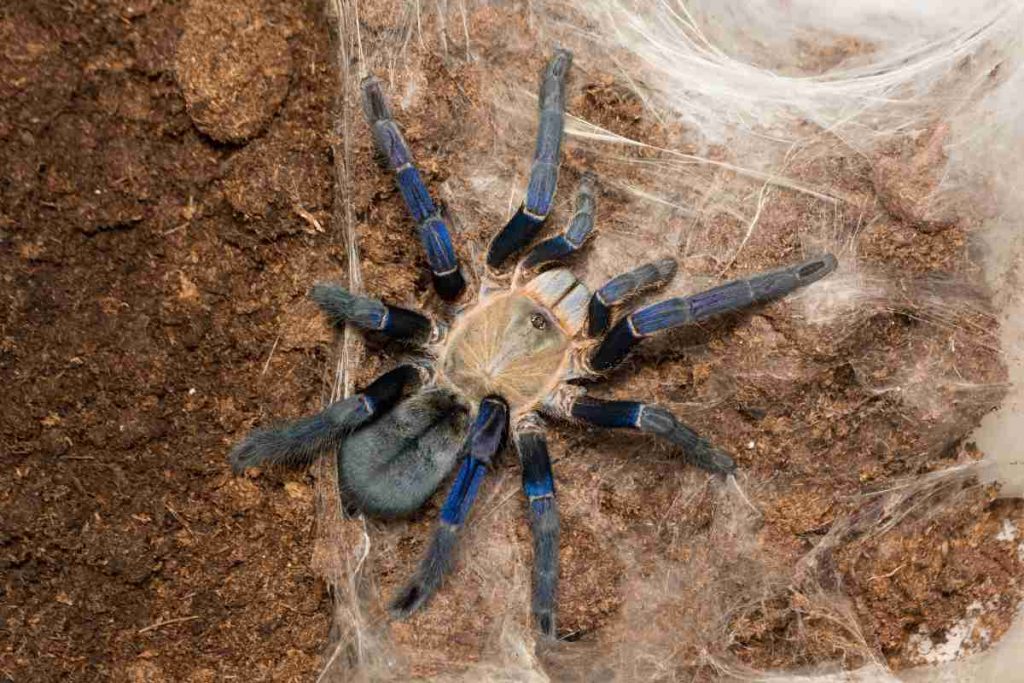
The males and females look very similar to each other in color until they molt! When this happens the males will have a much lighter tan coloration compared to the females.
Characteristics
- Vibrant blue legs with grey hair
- Light gray body, with darker gray chevrons
Habitat
- Tropical Rainforests
- Hiding in burrows or under logs
4. Singapore Blue Spiders
The Singapore blue “Omothymus Violaceopes” is native to southeast Asia Singapore and is also one of the most common blue spiders that are kept as pets in Asia.
Like the Cobalt Blue, the Singapore blue is a very shy and will usually flee! However, if threatened they can deliver a painful bite.
This spider is nocturnal and spends most of its time in tall trees. When they come out at night they typically hunt for invertebrates, like small birds, or lizards.
The most defining feature of the Singapore blue tarantula is its blue legs and brown and gold carapace. With Females being slightly more vibrant in color than the males.
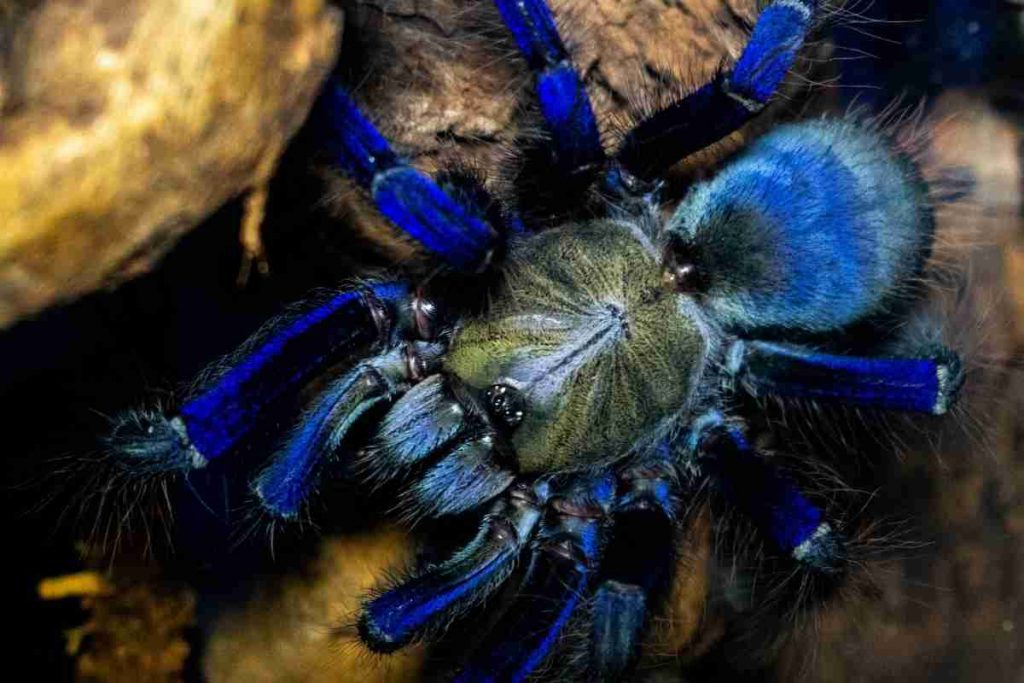
This spider is also very large and can reach an excess of 9 inches (23 cm) in length. They also have tiny white hairs on their legs and body which give them a “furry” appearance. If you notice these characteristics, then you’re likely looking at a Singapore Blue Tarantula.
Characteristics
- Bright blue legs with tiny white hairs
- Females are more vibrant in color
- Brown and gold carapace
Habitat
- Tropical Forests of Asia Singapore
- Spends most of its time in trees
5. Chrysilla Volupe
The Chrysilla Volupe is from the family Salticidae and is one of the smallest blue spiders, only reaching about 4 inches (5.44mm) in length. Because of their size, they are extremely rare to find in the wild, so if you have discovered one then congratulations, “you are one of the few”.
Not much is known about their behavior but they are believed to be “nocturnal hunters” and build small webs near the ground to catch their prey.
The Chrysilla Volupe is native to Sri Lanka, Nepal, India, and Bhutan, and is a very colorful spider!
Their legs are golden with purple shades, and their carapace has a slightly reddish-orange color with blue stripes.
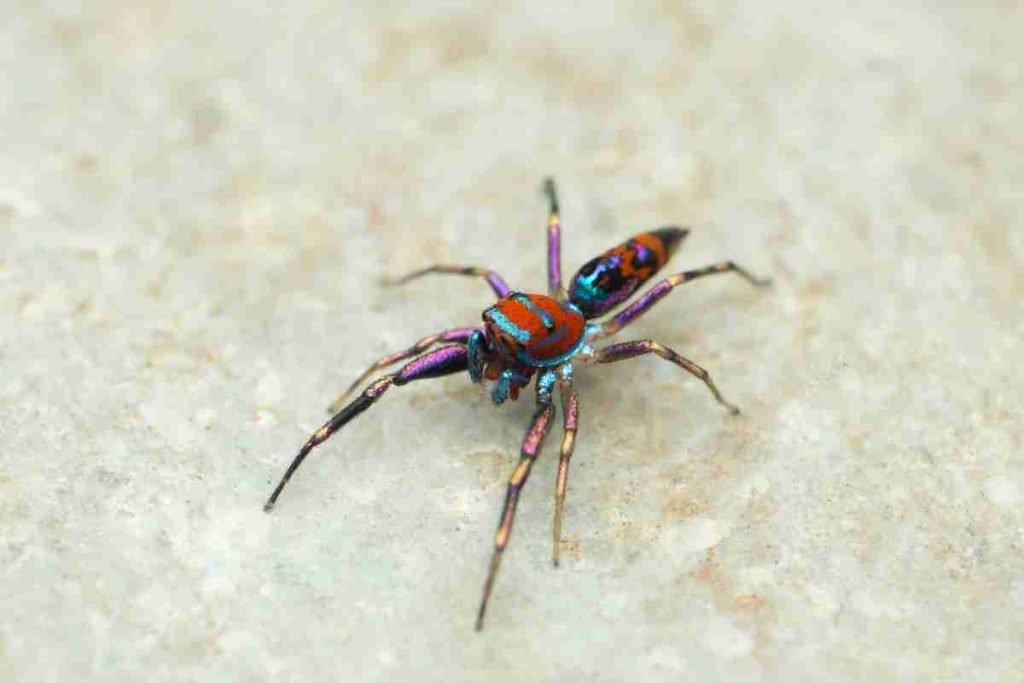
The females, on the other hand, have legs that are completely yellow with a gray carapace with grey eyebrows. If you see a spider with these colors then it is likely a Chrysilla Volupe.
Characteristics
- Golden legs with shades of purple
- Reddish-orange carapace with blue stripes
Habitat
- Rain forests of Sri Lanka, Nepal, India, and Bhutan
- Build small webs close to the ground
Also Read:
6. Metallic Blue Jumper
The metallic blue jumper spider, “Thiania Bhamoensis” is actually a type of jumping spider from the family “Salticidae” and is commonly found in “Bhamo” in northern Burma.
These spiders are also unique because they will molt and often lay their eggs, on green leaves which is very strange and unusual for spiders.
They typically make web funnels, in between these large leaves which they can then use to rest, and lay their eggs.
However, due to their size, they are also very tricky to find, so if your looking for one you should start by searching these leaves.
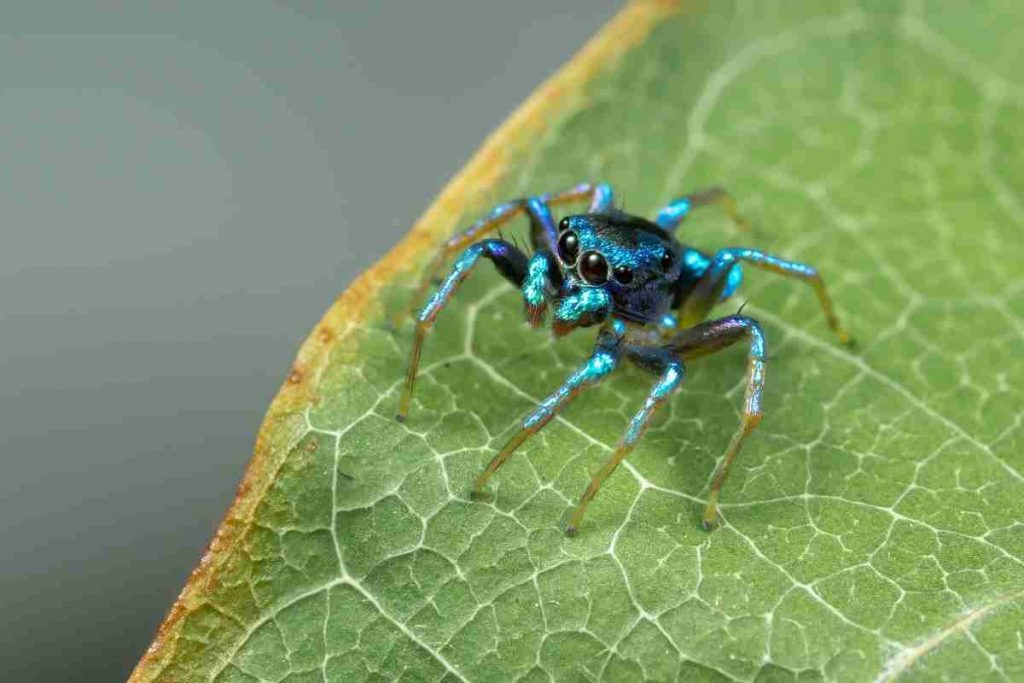
The Metallic Blue Jumper has a blue carapace with green markings on its abdomen. However, the females are greener and have black faces compared to the males. The males have a more vibrant blue color on their body and legs and their face is white, not black like the females.
Characteristics
- Blue carapace with green markings on its abdomen
- Females are greener with a black face
Habitat
- Native to Bhamo in northern Burma
- Can be found in gardens or roadside hedges
7. Greenbottle Blue Tarantula
The Greenbottle Blue Tarantula “Chromatopelma Cyaneopubescens” from the family Theraphosidae is native to the paraguaná peninsula and can be found in desert areas of northern Venezuela.
These spiders usually live under bushes and tree roots where they nest and make web funnels.
Not only does their webbing trap insects but it also protects them from the harsh desert climate. Their diet is made up of small crickets, roaches, worms, or anything they can find in the desert.
This spider is easily identifiable by its metallic blue legs and blue-green carapace getting its name the Greenbottle Blue Tarantula.
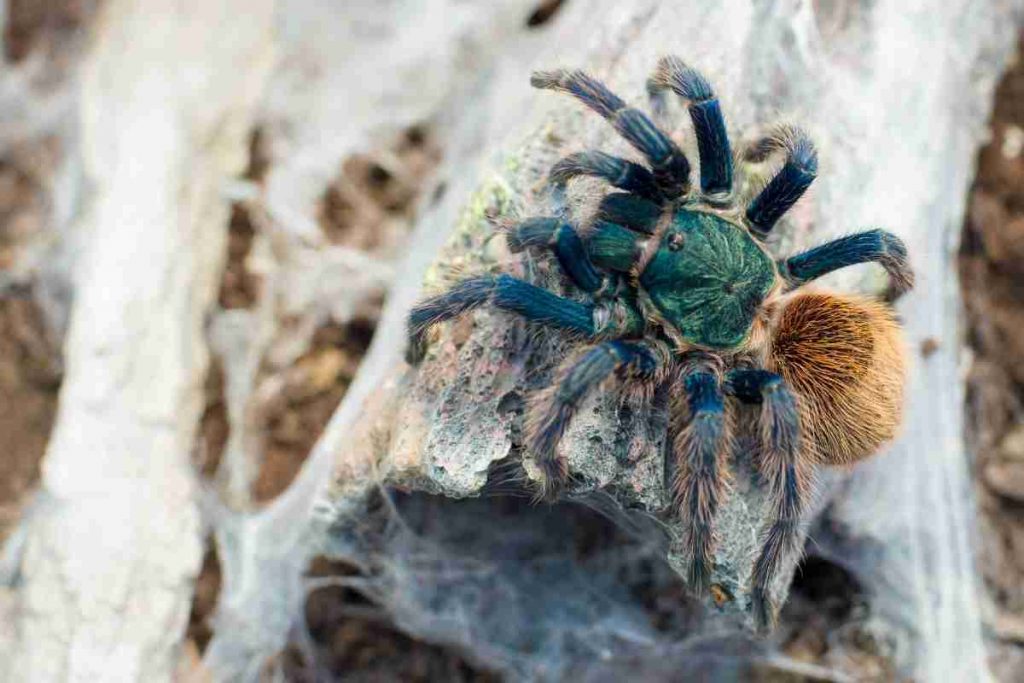
They can also grow quite large with some adults reaching up to six inches (15 cm) in length. This species of spider is also particularly attractive to hobbyists and collectors because of its vibrant colors and rarity.
Characteristics
- Metallic blue legs
- Blue-green carapace
Habitat
- Desert Areas of northern Venezuela
- Nests under bushes and tree roots
8. Antilles Pinktoe Blue Tarantula
The Antilles Pinktoe Tarantula “Caribena Versicolor” gets its name from their “pinkish hue” on the toes. This is a species of tarantula from the Theraphosidae family that is native to Martinique and Guadeloupe in the Caribbean Sea of South America.
They are known to be one of the more docile tarantulas, quite shy, and will usually stay hidden in their burrows or under leaves.
These blue spiders are also considered to be a medium-sized tarantula that can range from 4.5 to 6 inches in size.
The most defining feature of the Antilles Pink toe Tarantula is its pink toes. Their legs turn green with pink tarsi which are covered with purple hairs.
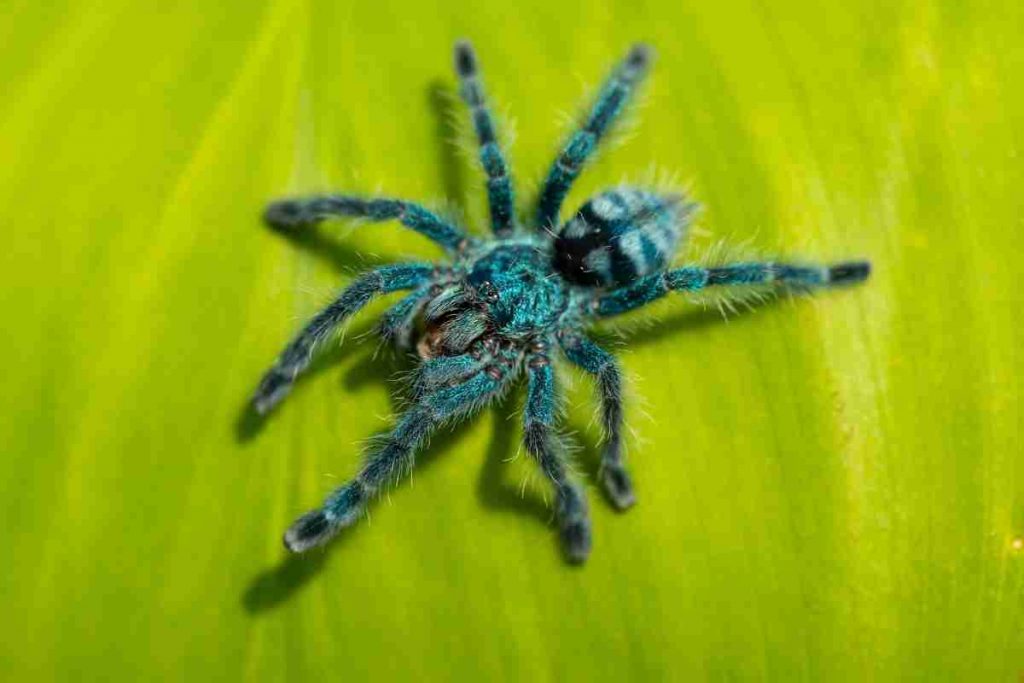
However, when they get older they start to lose their blue coloration and their carapace will turn green. The males are more brightly colored compared to the females. But, the females are much larger than the males who have smaller abdomens.
Characteristics
- Pinkish hue on the toes
- The males are more vibrant compared to the females
- Blue carapace that turns green as they age
Habitat
- Native to Martinique and Guadeloupe
- Can be found in their burrows under leaves
9. Sea-Green Northern Spider
The Sea-Green Northern Jumper “Cosmophasis Thalassina” is quite a common spider usually found in Malaysia to Australia. This species is from the same family as the metallic blue jumper the “Salticidae” family and is also very similar in appearance and size reaching about 1.2 and 1.8cm in length.
It’s believed that this spider was dispersed by man to the gardens and the parks of Queensland which has tropical and sub-tropical coastal regions.
The Sea-Green Northern Jumper has a very distinct coloring that helps it stand out from other spiders.
Its carapace is blueish-green and bronze in color with copper hairs and its legs are black with white and green patches.
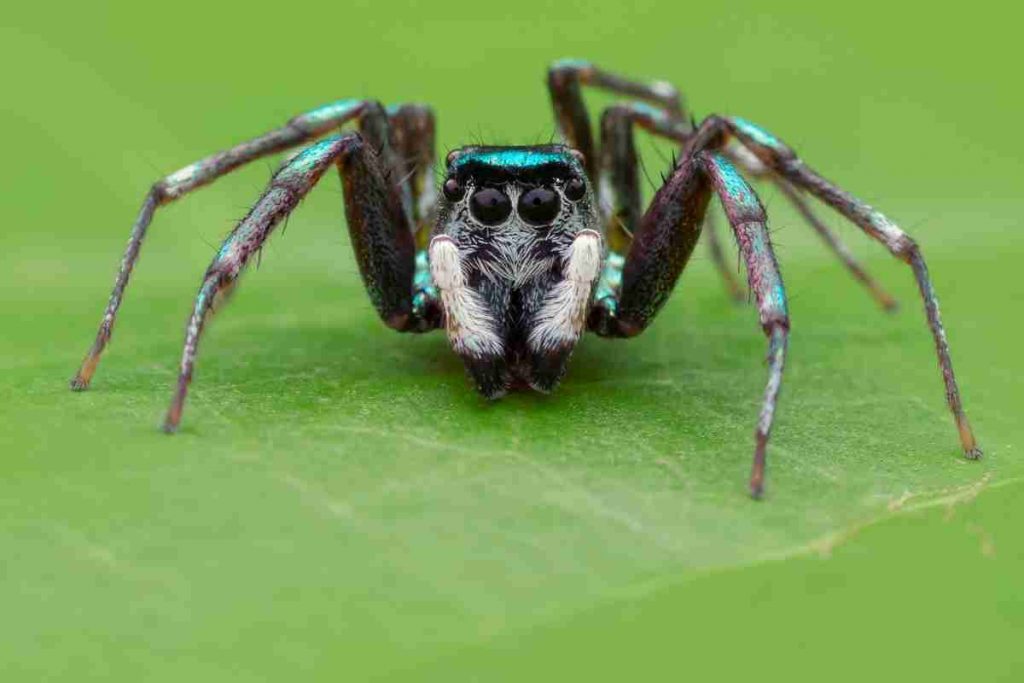
They also have an underlying broadband multilayer reflector that is blue in color. This is what gives them their blue hue and makes them so unique.
Characteristics
- Their carapace is blueish-green and bronze in color
- Legs are black with white and green patches
Habitat
- Tropical – Sub-Tropical Climates
- Nests in gardens and parks of Queensland
10. Golden Blue-Legged Baboon Spider
The Golden Blue-Legged Baboon Spider “Harpactira Pulchripes” is a species of tarantula from the family “Theraphosidae” and is native to South Africa in Grahamstown.
This spider gets its name from its “golden body” and blue legs. However, when they reach adulthood their colors will start to fade and they will turn more vivid orange or yellow.
The females are usually larger than the males reaching up to eight inches (14 cm) in length! While the males only grow to 10cm.
Females baboon spiders typically live longer than males up to 12 years and only 2 to 3 years for males.
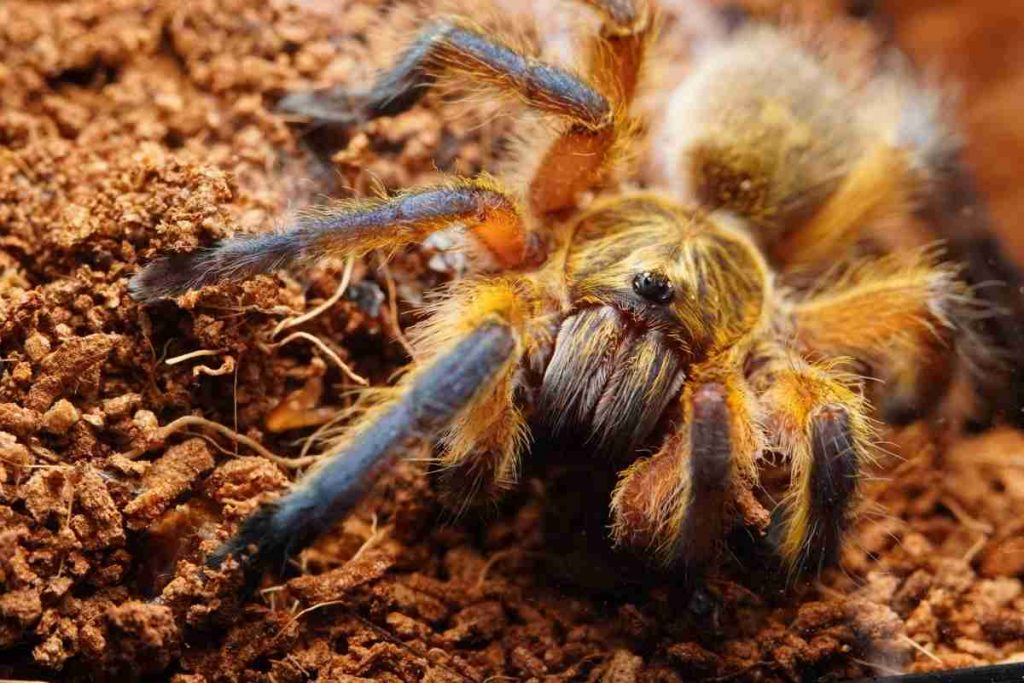
According to Sanbi the south African national biodiversity institute, the baboon spider is ground-dwelling, spending most of their time in their web burrows, and when they hunt they usually stay close to their burrow.
Characteristics
- Golden body with blue legs
- The body turns vivid orange or yellow with age
Habitat
- South Africa in Grahamstown
- Can be found close to the ground in burrows
11. Red-Headed Mouse Spider
The Red-Headed Mouse Spider “Missulena Occatoria” from the family “Actinopodidae” is a very common spider found in southern Australia. These spiders spend most of their time in open forests and desert shrublands where they dig small burrows to nest.
They are also members of the Missulena species, which are widely known for being wind-dispersed (ballooning) so they can travel long distances.
Missulena venom can also be very toxic, however, there’s been very few cases of any serious injuries! In fact, their bites only caused minor effects.
The most distinguishing feature of the Red-Headed Mouse Spider is its bright red head and jaws, and blue-black abdomen. However, the females look slightly different and have black that has a red tinge.
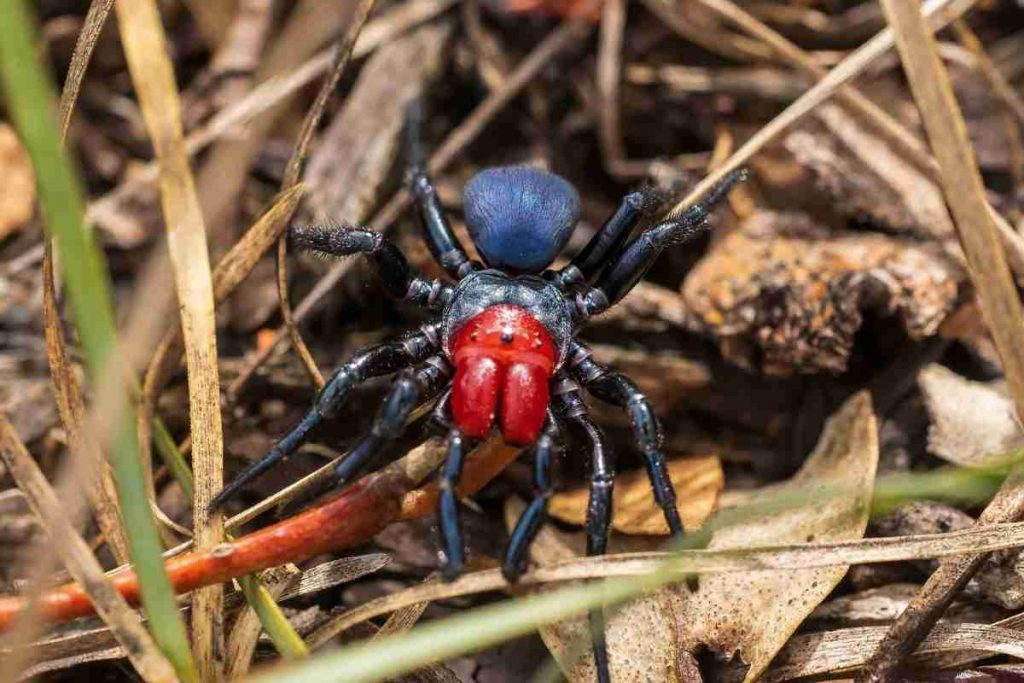
The females are also much larger than the males and can grow up to 24 mm. While the males only grow to 12 mm. Their legs are completely black with a glossy appearance.
Characteristics
- Bright redhead and jaws
- Blue-black abdomen
Habitat
- Open forests and desert shrublands
- Can be found on the ground in small burrows
12. Blue-Foot Baboon
The Blue-Foot Baboon spider, also known as the “Idiothele Mira” or the trap-door tarantula, is from the same species as the Golden Blue-Legged Baboon Spider but is much smaller. In fact, this spider is one of the smallest tarantulas, native to South Africa.
Females of the species grow to an average size of 4.5 inches, while males only reach an average of 3.5 inches.
This spider tends to live in wooded habitats and will construct densely silk-lined funnels usually under rocks and logs to catch its prey.
The most distinguishing feature of the Blue-Foot Baboon is its vibrant blue feet, toes” or tarsi, and metatarsi with grey legs.

Their carapace is black and golden the gold radiating within black giving it a “starburst” pattern, and the abdomen is also golden with black speckling. The Idiothele Mira is a much smaller species of tarantula with the females growing at 4.5 inches and the males at only 3.5 inches.
Characteristics
- Vibrant blue feet, toes
- The carapace is black and golden
- Legs are grey
Habitat
- Wooded Areas of South Africa
- Can be found in densely silk-lined funnels under logs
13. Bold Jumping Spider
The Bold Jumping Spider “Phidippus Audax” is a small, black-and-white spider. However, it does have a blue mouth which is why we added it to this list! This spider can be found throughout North America and is also known for its large eyes.
In fact, this spider has a total of eight eyes, arranged in two rows of four giving this Spider a wide field of view, which helps it to identify potential prey as well as any predators.
The most distinguishing feature of the Bold Jumping Spider is its large eyes and blue mouth.
The spider’s body and legs are black with white hairs that look like stripes however, the juveniles have orange stripes that turn white as they molt.
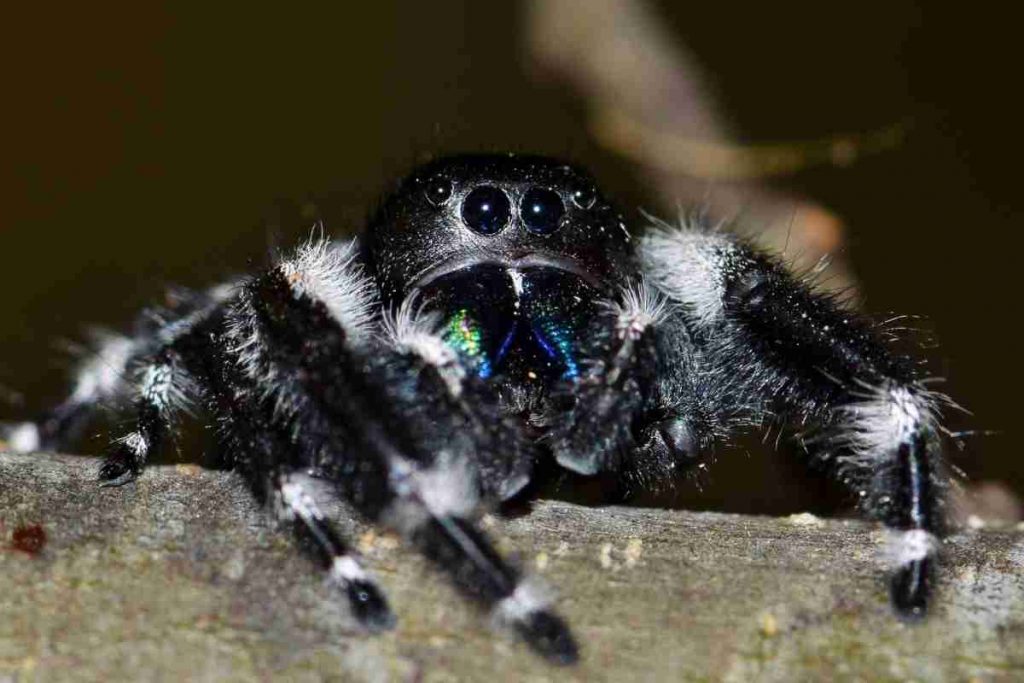
The females are usually larger than the males and can grow up to 18mm while the males only reach around 15mm.
Characteristics
- Has eight eyes with a blue mouth
- Body and legs are black with white hairs
- Juveniles have orange stripes that turn white as they molt
Habitat
- Can be found throughout North America
- Fields And Grasslands
14. Madagascar Hermit Spider
The Madagascar hermit spider “Nephilingis Livida” is an unusual creature that is found only on the island of Madagascar. These spiders are not social, and each one lives in its own individual burrow. The Madagascar hermit spider is also unique in that it lacks venom.
However, the reason why this spider is included in this list is that the color of its abdomen ranges from creamy brown to purple, and blue!
Although they are not considered dangerous to humans, their strange appearance and habits make them feared creatures among many native Madagascans.
Although they are not considered dangerous to humans, their strange appearance and habits make them feared creatures among many native Madagascans.
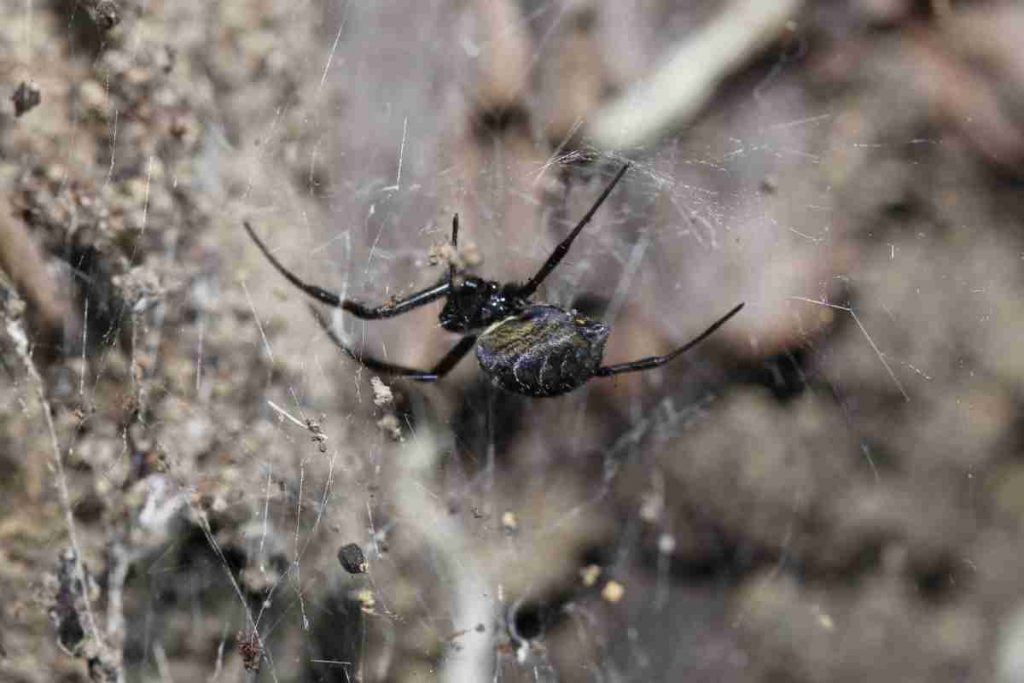
The Hermit Spider has a distinctively long, curved body, and its legs are covered in small spines. Its eyes are large and black, and its mouth is surrounded by long, feelers. Their abdomen can range from blue, brown, purple, or cream in color.
The females typically grow to 24mm in length while the males only grow to 5mm and will have an almost gold-colored sternum and grey abdomen.
Characteristics
- Black legs and body that are covered in small spines
- Abdomen ranges from brown to purple, and blue
Habitat
- Madagascar Islands
- can be found in burrows on the ground and in trees
15. Polychromatic Earth Tiger
The Polychromatic Earth Tiger “Haploclastus Devamatha” are the beautiful shy and elusive blue spiders that are rarely seen by humans. Some believe that they are a myth or legend, but those who have seen them know that they are real.
These blue spiders are native to the Western Ghats of India and are one of the most beautiful and intriguing spiders on the planet.
There are several key features that distinguish the polychromatic earth tiger carapace is purple while their legs and upper body are dark blue with tiny purple hairs.
Their size can vary between 3.94 To 5.91 Inches and typically make small burrows against mud banks or at the base of trees or shrubs.
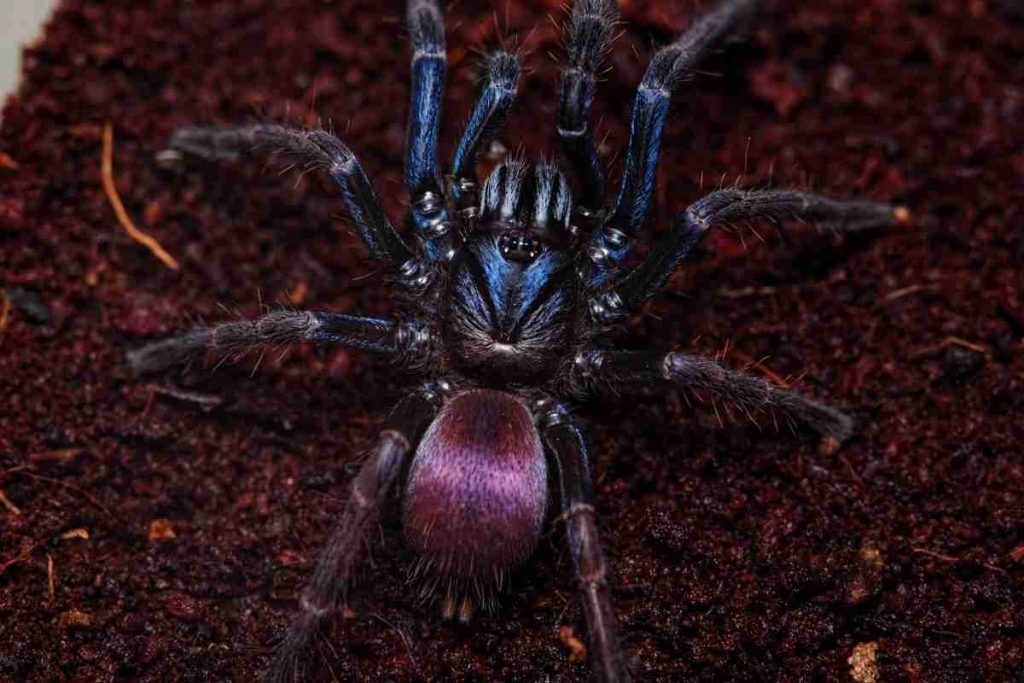
Characteristics
- Carapace has a deep purple color
- Legs and body have dark blue with tiny purple hairs
Habitat
- Native to the Western Ghats of India
- Can be found against mud banks and trees
Related Article:
- Why Is My Tarantula Not Eating? All Possible Reasons
- Harvestmen Spiders: Unveiling the Myths and Mysteries
16. Lace-Weaver Spider
Although the black lace weaver “Amaurobius Ferox” does not appear blue it does have some blue shade on its abdomen! and can be found throughout Europe and North America.
This spider prefers dark sheltered areas such as underneath logs or inside cellars and is 8 To 16mm in size.
The Black Lace-Weaver is easily distinguished by their black bodies and the pale skull pattern on their abdomens.
However, as mentioned, it does have some shades of brown, red, and blue, on its carapace.
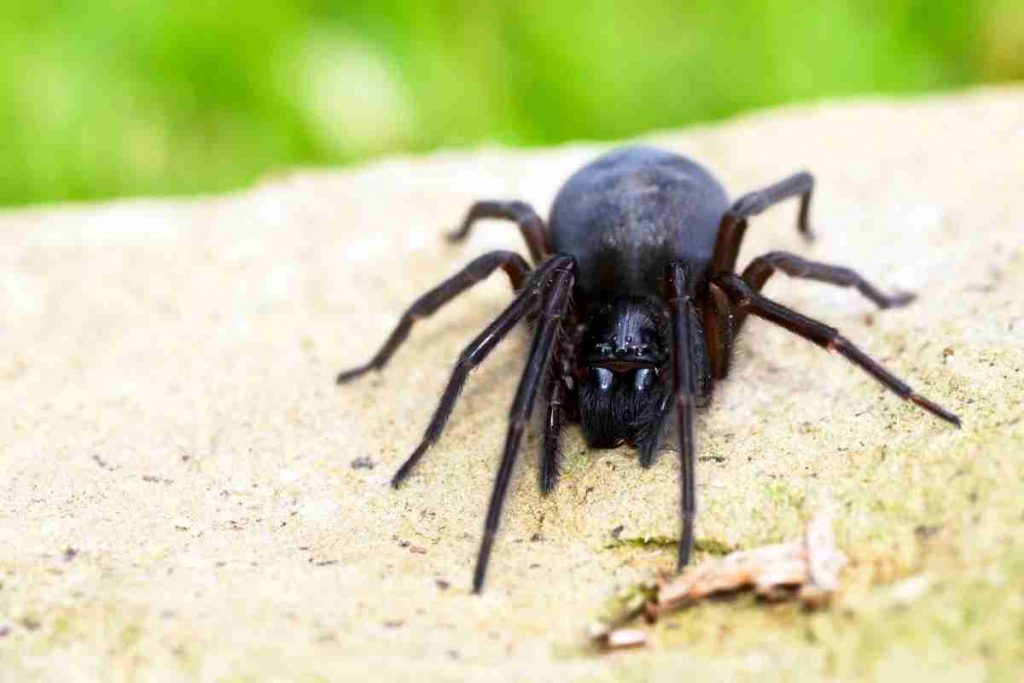
These are nocturnal spiders and the females are larger than the males growing at 16mm while the males grow to 10mm in length including the legs.
Characteristics
- Black body with shades of brown, red, and blue
- Pale skull pattern on their abdomens
Habitat
- Native to Europe and North America
- Prefers dark sheltered areas underneath logs or inside cellars
Conclusion
That concludes our list of 16 blue spiders! We hope you found this post informative and helpful in your quest to identify these beautiful blue spiders. As always, if you have any questions feel free to reach out to us via our contact page on this website.



